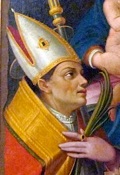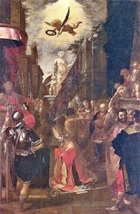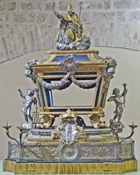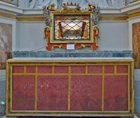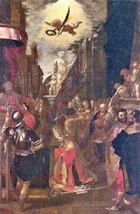Detail of St Felix Altarpiece (17th century)
Pinacoteca Comunale
According to the Martyrology of Usuard (9th century) St Felix had been the bishop of “Spellatensis”. (The associated legend is BHL 2886.)
A church near San Fedele was documented as “ecclesiam S. Felicis” in 1406, which indicates that the cult was established in the town at least by that time. However, the Roman Martyrology (1586) contains an entry under 18th May that “gave” this saint to Spoleto: “At Spoleto, St Felix, a bishop who obtained the palm of martyrdom under Emperor Maximian”. This re-designation seems to have prompted a campaign among the educated elite of Spello to reclaim him for their town. In 1601, Fausto Gentile Donnola, a local historian who was also serving on the Town Council, proposed that he should be adopted as the sole patron saint of Spello.
Fausto’s relative,
Taddeo Donnola, who was Prior of San Lorenzo, published a monograph in 1620 entitled: “
De loco martyrii sanctii Felicis episcopi spellatensis” (About the place of martyrdom of St Felix, Bishop of Spello), in which he claimed that San Fedele itself was the place in question. He was also probably responsible for the commissioning the altarpiece (1637) depicting the martyrdom of St Felix for
San Lorenzo. In this altarpiece, the martyrdom takes place in front of a huge statue of Venus, which is a reference to the fact that the remains of a Roman temple dedicated to Venus had been found during the construction of Villa Fidelia in ca. 1600.
After long and difficult negotiations, the Commune managed to secure the gift of a relic of
St Felix of Civitas Martana (a different St Felix, whose feast is on 30th October) from the
Abbazia di San Felice di Giano. The inscription on a reliquary in the
Pinacoteca Comunale records that a relic of this saint was translated to Spello at this time and that the reliquary itself was commissioned five years later. The reliquary was probably housed above the Altare di San Felice in
Santa Maria Maggiore. Its base contains holes for poles so that the relic could be taken in procession.
The relic was moved to another reliquary that is still housed there: this might have occurred in 1883, when the earlier reliquary was restored.
Contest with Blessed Andrew Caccioli
For reasons that are unclear, it was subsequently decided to adopt only one as the official patron of the town, and opinion was sharply divided. This is possibly reflected in two frescoes (ca. 1625) in San Ventura, which are attributed to Cesare Sermei:
-
✴St Felician preaching at Spello, on the right wall; and
-
✴a miracle of the Blessed Andrew, opposite.
The miracle in question, in which the Blessed Andrew brings a dead man back to life, is set in Spello, outside Sant’ Andrea. The fact that St Felician (the patron saint of Foligno) is depicted opposite could well have constituted a claim that he rather than St Felix had been the true evangelist of Spello.
The matter was resolved in 1629, when Bishop
Lorenzo Castrucci of Spoleto named St Felix as the sole patron saint of Spello.
Taddeo Donnola (mentioned above) was probably responsible for the commissioning the altarpiece (1637) depicting the martyrdom of St Felix for
San Lorenzo to mark his success. This depicts the martyrdom taking place in front of a huge statue of Venus, which is a reference to the fact that the remains of a Roman temple dedicated to Venus had been found near San Fedele in ca. 1600.
